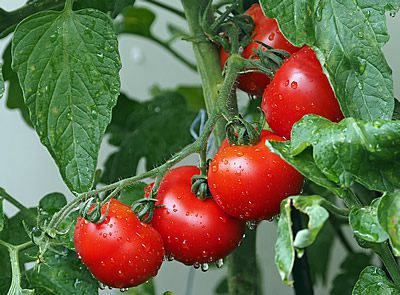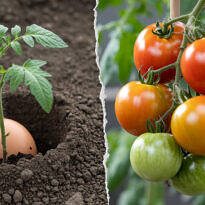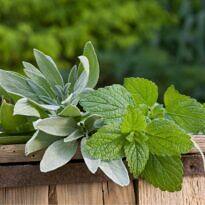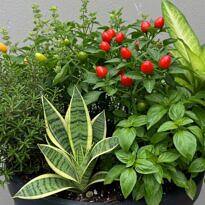We’re all well aware that tomatoes are among the most affected foods when it comes to pesticides. However, there’s a solution – growing tomatoes at home. Imagine yourself harvesting tomatoes for a delicious salad or a special Sunday dish, all without worrying about the harmful chemicals used in commercial farming that can compromise our health. Once you’ve mastered the art of growing tomatoes as outlined in this article, you’ll be able to enjoy an abundance of beautiful and flavorful homegrown tomatoes.
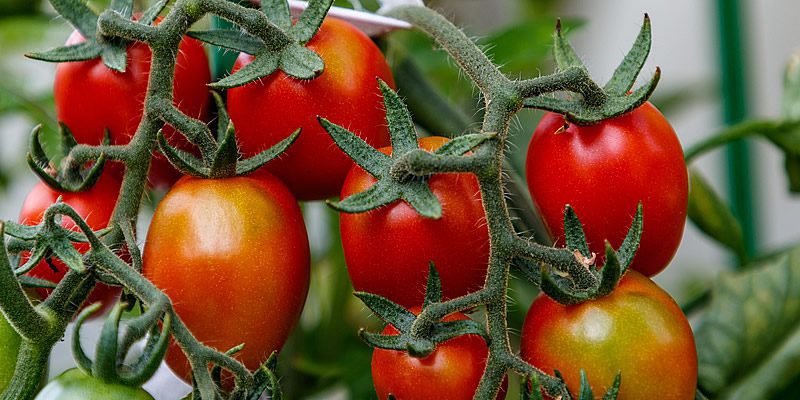
In this article, you’ll learn how to grow tomatoes, starting from seed selection, planting, protection, and harvesting. This guide is aimed at helping you achieve the highest possible yield from your tomato plants.
And yes, tomatoes are fruits! You’ll see me referring to tomato fruits throughout this guide.
Follow this process to plant your tomatoes and yield a bountiful crop!
If you’ve never bitten into a juicy tomato plucked fresh from your own garden, you’ve never truly experienced a real tomato. Once you’ve tasted one, you’ll never want to go back to supermarket tomatoes. Here’s a secret: caring for and planting tomatoes is easy. However, by following these tips, your tomato plants will yield even more succulent fruits. Here’s a useful tip: if you’re aiming for fresh fruits, have about three plants per person in your household. But if you’re looking to process the tomatoes (like making sauce), you’ll need five to ten tomato plants per person.
How to Start Tomato Seedlings:
Now, learn the easiest ways to start tomato seedlings from seeds or cuttings.
From Seeds:
Step 1: When to Plant? Growing tomatoes from seeds takes about 6 to 8 weeks from sowing to transplanting. Seeds planted in a sunny location will grow faster.
Step 2: Create a Nursery: Using reusable seedling trays is highly recommended, but you can also use plastic cups, clean yogurt containers, milk cartons, and the like.
Step 3: Pay atemption to the soil: The most important factor is the soil, which should be of high quality, lightweight, and well-draining. Moisten the mix before putting it in the container.
Step 4: Plant Tomatoes at the Right Depth: Tomato seeds are small; if you plant them too deep, they won’t germinate. Plant them at about half a centimeter deep, lightly covering them with moist potting mix.

Step 5: Provide Ample Light! Want large and sturdy tomato plants? Give them plenty of light. Seedlings that grow in the shade become elongated and weak. When it comes to sunlight, the more, the better!
Step 6: Maintain Moisture: Excess water is one of the fastest ways to kill any plant, so keep an eye on soil moisture. It should be slightly damp but not waterlogged. Use transparent plastic or plastic wrap over the container’s opening to retain moisture. Once germination occurs, remove the plastic to allow for airflow. This effect is similar to that of a greenhouse, which is a great strategy for dry climates.
Step 7: Use Natural Fertilizers: To ensure your seedlings grow even stronger and healthier, use water-soluble organic fertilizers.
If you’re wondering about the right soil for planting tomato seeds, opt for seedling substrate if available or use garden soil enriched with worm castings.
Transplanting Seedlings
Though transplanting seedlings might seem straightforward, there’s a little secret to enhance production. Transplanting seedlings, in general, is quite simple: just place the plant in a new spot and you’re done.
However, tomato seedlings are unique. They appreciate being buried deep. They can form new roots along their stems, so bury them up to the first set of leaves. With a larger root system, the plant will be healthier and more robust.
Propagation by Cuttings
Who hasn’t propagated a plant using cuttings? Tomatoes can be propagated this way too, allowing you to clone your best tomatoes.
If you know someone with a gorgeous tomato plant bearing large and tasty fruits, know that you can easily clone that plant. Tomatoes can form roots along any stem, making propagation straightforward. All you need is a stem and a pot filled with lightweight, fluffy soil.
The advantage is that you can speed up the transplanting process. By keeping the tomato cuttings warm (using a greenhouse or similar setup), the transplanting time can be reduced to just 10 to 14 days!
Water Rooting:
Rooting tomato cuttings in water is simple, as tomato plants quickly develop roots. Start by selecting some young branches, preferably ones without buds.
Using sharp scissors, cut about 15 centimeters of a growing branch. You can then either dip the cut end in water or plant it directly into the soil. In water, roots will appear within a week, and by the end of the second week, they’ll be ready for transplanting.
Tomatoes are perennials and can thrive for years in warm climates. However, their fruit production tends to decrease in subsequent years. But with propagation, you’ll always have new and high-quality seedlings.
Just remember to clone plants that yield the best results and tastiest fruits since the cloned seedlings will inherit all their characteristics.
Once the seedlings are well-developed, you’ll need to perform the transplant and ensure suitable soil conditions.
Soil:
Tomatoes aren’t overly picky about the soil they’re grown in. However, a little help won’t hurt. Just like most vegetables, they prefer fertile, well-draining soil with a pH of 5.8 to 7.0.
Tomatoes thrive in soil rich in organic matter. You can incorporate organic compost into the soil during preparation, and having a compost heap to add to the soil will make it even better.
Another tip is to prepare a natural fertilizer rich in phosphorus and potassium. You can use dried and crushed pumpkin seeds along with banana peels. This will result in more flowers and, consequently, more fruits on your tomato plants.
Tomatoes in Containers:

Tomatoes are commonly grown in gardens, but you can also cultivate them in pots. Planting tomatoes in pots has its advantages, offering complete control over substrate, light, watering, and drainage. I’ll delve deeper into this topic towards the end of the article when I teach you how to plant tomatoes in pots.
Support
Some tomato varieties thrive on the ground, but using supports can prevent this and offer several benefits in return:
- Increased exposure to sunlight, leading to enhanced production.
- Improved fruit and foliage quality.
- Pruning and fertilizer application become easier.
- Air circulation, reducing the incidence and spread of fungal diseases.
- Plants become more resilient against damaging winds.
The simplest support method I know is driving stakes into the soil and tying the branches to the stakes with twine. This is sufficient, but if you prefer another model, I recommend checking out Pinterest for useful ideas.
Watering Done Right
How much and when should I water my tomatoes?
The answer: it depends.
Several factors come into play. For instance, younger plants require more water, and warmer weather affects their water needs. The type of soil, whether it’s well-draining or not, and whether the tomatoes are in pots or beds also matter. While everyone would love a straightforward “Water three times a week” recommendation, the truth is more nuanced.
The key is to assess and water when needed. Here are some tips:
In Pots: Tomatoes in pots depend entirely on you. Avoid letting the plants dry out excessively between watering. Lack of water can stress the plant and reduce fruit yield.
Timing: Water less during rainy and cold days, but increase watering on dry and hot days.
Soil Type: There are three main soil types: sandy, silty, and clayey. Sandy soil doesn’t retain water well, while clayey soil holds water the most.
Plant Age: Young tomato seedlings need more water than mature ones. Their roots are near the surface, making them susceptible to drying out.
The golden rule for watering is to check the soil and water deeply (deep watering is better than frequent shallow watering).
If the soil surface is dry, dig a bit to check the roots. Water in the morning; evening watering can encourage fungal growth. Avoid wetting leaves excessively for the same reason.
Secret Irrigation Technique
You can efficiently water the deeper soil layers using a simple method. All you need is a plastic bottle. Drill several holes in the bottle for water to seep through. Bury the bottle with the neck exposed about 5 centimeters above the soil. This way, you can refill the bottle with water.
This technique ensures the deeper roots stay moist.
In conclusion, water in the morning, assess the plant’s need for water, and understand your soil.
Lighting
When it comes to lighting, there are some considerations. Tomatoes love sunlight for optimal growth, but there are nuances. If the fruit is exposed to afternoon sun, it can get too hot, leading to increased humidity at night, which can cause diseases.
Another aspect is a study conducted in the US by the University of California (they’re tomato enthusiasts). It showed that tomatoes need shade to cool down during specific hours. This key time is when natural tomato flower pollination occurs (usually between 10 AM and 2 PM). Thus, optimal yields come from tomato plants with shade during these hours.
However, following these tips might reduce the sunlight tomatoes receive, as they require at least 6 hours of direct sunlight daily. To solve this, hide the fruits among the foliage to prevent overheating, ensuring sufficient light and fruit protection.
Fertilization
The best tomato plant fertilizer contains macronutrients like nitrogen, phosphorus, and potassium, along with essential micronutrients such as magnesium, calcium, boron, zinc, etc.
Whether you’re growing tomatoes from seeds or purchasing seedlings, understanding plant nutrition is crucial. Bone meal is a great way to add organic fertilizer while ensuring tomatoes receive sufficient phosphorus for strong root development and bountiful fruit production.
Another recommendation involves using crushed pumpkin seeds mixed with crushed banana peels for added phosphorus and potassium in the soil.
Common Signs of Excess Nitrogen Fertilization
Yellowing tomato leaves could indicate excessive nitrogen in the soil. Under excess nitrogen conditions, tomatoes might not absorb enough water, leading to yellowing of older leaves. However, leaf yellowing can signify various issues. Excess nitrogen could lead to excessive foliage growth or loss of leaves, delaying flowering.
Identifying these problems requires experience.
Pruning Tomatoes
There are various tomato pruning methods based on the tomato type and support structure. Pruning is especially beneficial for indeterminate tomato varieties.
Pruning redirects the plant’s energy from excessive growth toward flowering, resulting in more flowers and thus more tomatoes. Improved airflow also reduces disease risk. Pruned plants have fewer leaves, allowing air to circulate and leaves to dry faster, minimizing fungal growth.
Additionally, fewer leaves enable easier identification of hidden insects. Timely pruning also directs energy toward fruit development instead of leaf production. When planting, remove lower leaves to allow for deep planting.
Remove flowers during planting to channel energy into leaf growth initially. Keep removing flowers until plants are 40-50 centimeters tall to direct energy to roots.
Most tomato pruning involves removing side shoots forming in leaf axils, where lateral branches meet the stem. Focus on removing shoots below the first fruit cluster to prevent delayed tomato development. However, keep upper shoots, as they’ll produce flowers and fruits.
Try to remove shoots when they’re small to avoid large open wounds.
As They Grow
If left unattended, tomato plants can turn into sprawling bushes with stems bending under the weight of fruit. Fruit and foliage on the ground are more susceptible to pests and diseases. Pruning and using plant supports can help.
A crucial tip: if you live in a sunny area, avoid excessive foliage removal to protect the tomatoes. Sun exposure can cause spots, burns, and attract fungi.
Pollination
Many gardeners leave tomato pollination to bees and other pollinators, but taking matters into your own hands can lead to a better harvest.
Tomatoes, like many plants, are self-fertilizing. This means a single plant can yield fruits without external intervention. While wind and bees typically move pollen, what do you do when nature falls short?
High temperatures and humidity can harm tomato yield. This is where manual pollination comes in. Manual pollination of self-fertilizing plants is easy and requires minimal time or resources. All you need are your fingers to gently vibrate the flowers. Vibrations, like those caused by wind or bees, release pollen and facilitate pollination. Repeat this process daily for optimal results.
Dealing with Pests and Diseases
At some point, you’ll need to address issues with your tomato plants. Here’s how to handle them.
Main Pests and Solutions:
- Whitefly: Detergent, garlic, and pepper solution.
- Spider Mites: Onion solution.
- Leaf Miner Larvae: Alcohol and garlic repellent.
- Aphids: Garlic and onion extract.
By promoting air circulation through pruning and morning watering, you’re already helping prevent fungal diseases. Fungal issues are common and should be avoided at all costs. Recognize symptoms such as leaf spots, cracked fruit, and plant death.
Best Tomato Varieties
Some tomato types stand out for their resistance, flavor, and productivity:
- Cherry Tomatoes;
- Italian Tomatoes;
- Carmen Tomatoes;
- Dutch Tomatoes;
- Débora Tomatoes;
- Persimmon Tomatoes;
- Grape Tomatoes;
Determinate vs. Indeterminate
Tomatoes are also categorized based on their growth:
Determinate:
- Shorter, compact, bushy plants;
- Require less pruning;
- Growth is limited;
- Low maintenance;
- Great for container gardening;
- Also known as bush tomatoes;
- Ripen all fruits simultaneously;
Indeterminate:
- Can grow almost limitlessly, up to 10 meters;
- Continuously produce flowers and fruits;
- Require extensive pruning;
- Necessitate support structures;
How to Plant Tomatoes in Pots
Growing tomatoes in pots is a suitable alternative for those without garden space yet still desire homegrown tomatoes. Here are some tips for planting tomatoes in pots.
Location matters. You can place your tomato pots almost anywhere, but ensure they receive at least six hours of sunlight. Also, avoid crowding pots to promote airflow and reduce fungal spread. Keep a distance of at least 1 meter.
Choose the right pot—opt for a 15-20 liter pot with drainage holes. Prepare well-draining and loose soil, preferably enriched with organic matter.
Opt for determinate tomato varieties for container gardening, as they stay compact (typically 1 to 1.5 meters tall). Plant deep to encourage root growth.
Add organic fertilizer to provide chemical-free nutrients. Regular and deep watering is essential. Check the soil moisture with your finger before watering.
Avoid watering foliage in the late afternoon to reduce the risk of fungal issues.
Support your tomatoes, especially when they grow tall. Staking is effective. Prune as needed. Pruning isn’t crucial unless plants grow too closely. Trim branches blocking airflow and sunlight penetration.
How to Plant Cherry Tomatoes
Have you ever eaten cherry tomatoes straight from the vine?
Cherry tomatoes are like juicy little gems, packing the concentrated flavor of their larger counterparts. They’re sweet, perfectly shaped, and have thinner skin than regular tomatoes. Their benefits include:
- Rich in calcium, iron, lycopene, and vitamins A and C;
- Easy to grow, with resistance to certain diseases and pests;
- Rapid growth and flowering;
- Some varieties boast colorful fruits.
You’ve already learned about optimal soil, preparation, lighting, and watering. Apply these concepts to planting and caring for your cherry tomatoes.
But what if you lack garden space and still want cherry tomatoes? Planting them in pots is the solution.
How to Plant Cherry Tomatoes in Pots
Keep in mind that you’ll need relatively large containers for this method. A 15-liter pot per plant is sufficient. Don’t forget to create drainage holes at the bottom.
Most cherry tomatoes are indeterminate, meaning they don’t all ripen simultaneously. Instead, the plant continues to grow and produce as long as you harvest ripe tomatoes.
This approach provides you with a steady supply of cherry tomatoes throughout the year. You can typically have 2 to 3 cherry tomato plants per person. These tomatoes also require support, as they can grow vigorously. A cage is ideal for supporting them.
Essential Nutrients
One of the secrets to healthy plants lies in providing primary nutrients: nitrogen, phosphorus, and potassium. These nutrients are vital for plant growth. While you’ve learned how to add phosphorus and potassium to the soil, you can boost nitrogen by incorporating organic matter. Planting cherry tomatoes in pots is easy and perfect for any backyard gardener. If you have a spare corner, consider filling it with a cherry tomato plant.
In Conclusion
Learning how to plant tomatoes is straightforward, as they are inherently easy to grow and propagate. However, to achieve juicy and beautiful tomatoes, you’ll need to focus on soil, planting, watering, and maintenance.

